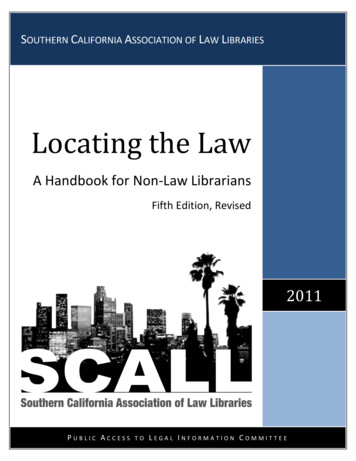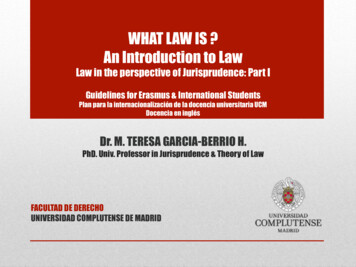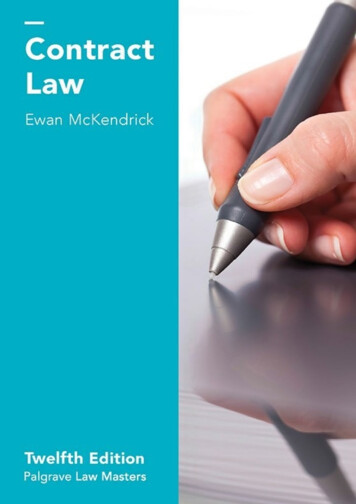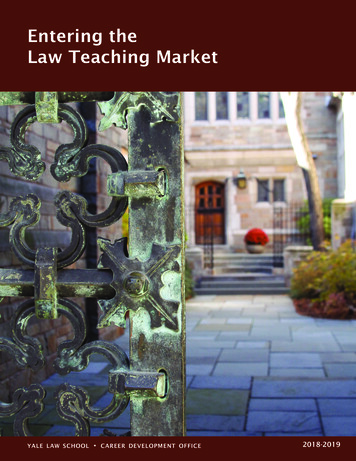
Transcription
SOUTHERN CALIFORNIA ASSOCIATION OF LAW LIBRARIESLocating the LawA Handbook for Non-Law Librarians Fifth Edition, Revised2011PUBLIC ACCESSTOLEGAL INFORMATION COMMITTEE
2009, 2011 Southern California Association of Law Libraries
Locating the LawA Handbook for Non-Law LibrariansFifth edition,RevisedEdited by June KimSouthern California Association ofLaw Libraries2011
Public Access to Legal Information (PALI) Committee,Southern California Associationof Law LibrariesJune Kim, Chair2010-2011 COMMITTEE MEMBERS:Joan Allen-Hart, Judy K. Davis, Catherine Deane,Esther Eastman, Michelle Gorospe, Curtis Jones,Jennifer Lentz, Janine LiebertDavid McFadden, Patrick Meyer, and Lisa Shultz
ForwardThe law should surely be accessible at all times and to everyone.--Franz KafkaThe Southern California Association of Law Libraries (SCALL) Committee on PublicAccess to Legal Information (PALI) is charged with providing consulting services andrelated educational programs to public and other non-law libraries offering open accessto legal information.Public access to legal information is extremely important in today’s rapidly changinglegal environment. In recognition of the public’s need to know their legal rights andhow statutes, administrative regulations, and judicial cases affect their lives, SCALL ispleased to present the fifth edition of Locating the Law: A Handbook for Non-LawLibrarians, 2009. This publication, as each of the earlier editions pointed out, is notintended to replace a detailed legal research guide nor is it to be a substitute for theadvice of a licensed attorney. Locating the Law is intended to provide basic informationabout California and federal legal materials: what they are, how they are organized,and how to use them.The full text of the fifth edition of Locating the Law will be available free of charge on theSCALL Web site. For economic and environmental reasons the publication will nolonger be produced in print format. Additionally, the electronic only version will makeupdating more effective and efficient. Web site addresses have been supplied for mostof the materials discussed in each chapter. Further, when Locating the Law is viewedover the Internet, readers will be able to find sources of information almost instantly byclicking on the hyperlinked text provided throughout this publication. As used in thishandbook, Internet access means electronically available. When commercially availableInternet services are described within, they are identified as fee-based services.As a member of SCALL for fifteen years (1992-2007) and former PALI chair, I know thatprevious editions of this handbook have been used by librarians both within andoutside of California and have assisted paralegals, law students, legal administrativeassistants, attorneys and others. The editor and authors hope the fifth edition willcontinue to be an important resource for locating legal information.Readers with questions, comments and suggestions for revisions may use the Contact Uslink on the Locating the Law page at i
LOCATING THE LAW, FIFTH EDITIONWith your help, the members of the PALI Committee will strive to keep this new onlineedition as up-to-date as possible.October 2009Ruth J. HillDirector of Library Services &Associate Professor of LawOliver B. Spellman Law LibrarySouthern University Law Center56 Roosevelt Steptoe DriveBaton Rouge, LA 70813ii
PrefaceThe Southern California Association of Law Libraries (SCALL) Committee on PublicAccess to Legal Information (PALI) is pleased to present the revised fifth edition ofLocating of Law: A Handbook for Non-Law Librarians.The revision of the fifth edition of Locating the Law was completed in November 2011.Because most of the edits involved updating links or deleting obsolete resources, theCommittee decided that this version of Locating the Law did not include enoughsubstantive changes to qualify as a new edition. A couple of changes, however, do merita mention here. New PALI member Janine Liebert suggested several new titles to addto Chapter 10: Bibliography of Self-Help Resources. In addition, the list of commonabbreviations in law previously included at the end of Chapter 2: How to Read a LegalCitation is now Appendix B. We hope that providing this handy list in its new locationas a separate appendix will make it more accessible to researchers.I would like to thank the PALI members who updated the 2009 versions of theirchapters: David McFadden, Joan Allen-Hart, Patrick Meyer, Lisa Schultz, JenniferLentz, and Esther Eastman. I would also like to acknowledge the assistance provided byJudy K. Davis and several new members of PALI, Catherine Deane, Michelle Gorospe,Curtis Jones and Janine Liebert. Also, PALI thanks Ramon Barajas for his technicalassistance.On behalf of the 2010-2011 Committee on Public Access to Legal Information, I hopethat the revised fifth edition of Locating the Law will be a useful resource to publiclibrarians in California and elsewhere.November 2011June KimChair, Public Access to Legal Information Committee (2010-2011)Southern California Association of Law Librariesiii
LOCATING THE LAW, FIFTH EDITION, 2011iv
AcknowledgmentsThe 2008-2009 Public Access to Legal Information (PALI) Committee is pleased topresent the fifth edition of Locating the Law: A Handbook for Non-Law Librarians. The newedition reflects the hard work, diligence and expertise of over a dozen California lawlibrarians, all of whom volunteered their time to this project. Given that eight yearshave passed since the last edition, it should not surprise readers to know that thechanges to this publication are extensive. The Committee had its work cut out for it and,I believe, rose to the challenge.As editor, I had the privilege of working with all of the members of the Committee.Especially during the last four months, 1 when the editing process was most intensive, Ibecame exceedingly familiar with each person’s contributions to this publication. I hopeto convey my appreciation of the Committee’s accomplishments here, as well as in thequality of the final product, which I hope meets the expectations of the Committeemembers. The chapters and appendices are excellent as separate work, but they areeven better together, in what I hope is a cohesive whole.The chapter and appendix authors are Joan Allen-Hart, Laura A. Cadra, Karla Castetter,Esther Eastman, June Kim, Jennifer Lentz, David McFadden, Patrick Meyer, and LisaShultz. A detailed list is in the table below.SECTION/CHAPTERAUTHORPREFACERuth HillTITLE/AFFILIATIONDirector of Library Services & Assoc.Professor of Law, Southern UniversityLaw Center (Baton Rouge, LA)ACKNOWLEDGMENTSJune KimSenior Reference Librarian, UCLASchool of Law1Mid-May 2009 through September 2009.v
LOCATING THE LAW, FIFTH EDITIONCHAPTER 1: IntroductionKarla CastetterLibrary Director, Thomas JeffersonSchool of LawCHAPTER 2: How to Read aDavid McFaddenwestern Law SchoolLegal CitationCHAPTER 3: Basic LegalJoan Allen-HartJoan Allen-HartAssistant Director, Retired, San DiegoCounty Public Law Libraryvs. Legal AdviceCHAPTER 5: California LawAssistant Director, Retired, San DiegoCounty Public Law LibraryResearch TechniquesCHAPTER 4: Legal ReferenceSenior Reference Librarian, South-Laura A. CadraHead of Reference/Foreign & Int’l LawLibrarian, Loyola Law School LosAngelesCHAPTER 6: Bibliography ofPatrick MeyerJefferson School of LawCalifornia ResourcesCHAPTER 7: Federal LawAssociate Library Director, ThomasKarla CastetterLibrary Director, Thomas JeffersonSchool of LawCHAPTER 8: Bibliography ofJune KimSenior Reference Librarian, UCLASchool of LawFederal Law Resourcesvi
LOCATING THE LAW, FIFTH EDITIONCHAPTER 9: Assisting Self-Laura A. CadraRepresented Litigantsandin CaliforniaJune KimCHAPTER 10: Bibliography ofSelf-Help ResourcesCHAPTER 11: Availability,Head of Reference/Foreign & Int’l LawLibrarian, Loyola Law School LosLisa SchultzJoan Allen-HartAccessibility andAngeles (Laura) and Senior ReferenceLibrarian, UCLA School of Law (June)Faculty Services/Reference Librarian,Loyola Law School Los AngelesAssistant Director, Retired, San DiegoCounty Public Law LibraryMaintenance of LegalCollectionsCHAPTER 12: Major LawJennifer LentzPublishersAPPENDIX A: Glossary ofReference Librarian, UCLA School ofLawJune KimSenior Reference Librarian, UCLASchool of LawLegal TermsAPPENDIX B: CaliforniaHead of Collection Development &Esther EastmanReference Librarian, LA Law LibraryKarla CastetterLibrary Director, Thomas JeffersonCounty Law LibrariesAPPENDIX C: CaliforniaSchool of LawLaw Schoolsvii
LOCATING THE LAW, FIFTH EDITIONPALI Committee members, not included in the above list of authors, and who assistedin the editing process are Judy K. Davis, Head of Access Services, USC Law Library,and Tammy Pettinato, former reference librarian at UCLA Law Library. They acted astwo extra pair of eyes, for which I am grateful. Special thanks also to David McFadden,a chapter author, who volunteered to assist in the editing process.I also want to thank Ruth Hill, former PALI chair, who graciously agreed to write thepreface to the fifth edition. Ruth was a long-time member of SCALL before she movedto Baton Rouge, Louisiana to become library director of Southern University LawCenter. Moreover, two people deserve special mention: Jessica Wimer, 2008-2009President of SCALL, for her encouragement and support and Ramon Barajas, theSCALL Webmaster, for his technical skills and expertise.Last but not least, many, many thanks to Laura Cadra, who provided invaluableassistance to me during the past four months. I consulted with Laura on all issues forwhich I needed a second opinion—from structure and organization of the chapters,formatting, whether to include or exclude information, and much more. She also helpedin the editing process by reviewing several of the chapters. In addition, she graciouslyagreed to co-author the new chapter, Assisting Self-Represented Litigants in California(Chapter 9).On behalf of the chapter authors, the PALI Committee members, Ruth Hill, JessicaWimer, and Ramon Barajas, I hope that the fifth edition of Locating the Law: A Handbookfor Non-Law Librarians will be a useful resource to public librarians in California andelsewhere.June Kim, ChairSCALL Public Access to Legal Information Committee2007-2009viii
Table of ContentsFORWARD (2009) .iPREFACE . iiiACKNOWLEDGMENTS (2009) . vCHAPTER 1: Introduction . 1CHAPTER 2: How to Read a Legal Citation. 13CHAPTER 3: Basic Legal Research Techniques . 21CHAPTER 4: Legal Reference vs. Legal Advice . 46CHAPTER 5: California Law . 54CHAPTER 6: Bibliography of California Resources . 69CHAPTER 7: Federal Law . 97CHAPTER 8: Bibliography of Federal Law Resources . 115CHAPTER 9: Assisting Self-Represented Litigants in California . 145CHAPTER 10: Bibliography of Self-Help Resources . 157CHAPTER 11: Availability, Accessibility and Maintenanceof Legal Collections. 198CHAPTER 12: Major Law Publishers . 208APPENDICES:APPENDIX A: Glossary of Legal Terms. 214APPENDIX B: Common Abbreviations in the Law. 222APPENDIX C: California County Law Libraries . 225APPENDIX D: California Law Schools. 255vii
LOCATING THE LAW, FIFTH EDITION, 2011viii
Chapter 1INTRODUCTIONThis introductory chapter gives an overview of legal research and provides generaldescriptions of the sources one should consult. Detailed descriptions of California andfederal law may be found in Chapters 5 and 7, respectively. In addition, see Chapters 6and 8 for detailed bibliographies of California and federal legal materials.Contents: Categories of Legal Research Sources Constitutional Law Statutory Law Case Law Administrative Law How It All Fits Together Basic Tips for Locating the Law Selected BibliographyCategories of Legal Research SourcesThe goal of most legal research is to identify the answer to one’s legal question. Were myrights violated? How do I probate a will? Can I adopt my stepchild? Finding the answer orsolution requires research into the applicable legal basis or authority. In other words,which laws apply to my legal issue?In order to identify applicable laws, one must first have a basic understanding of theU.S. legal system. In the United States, there is a federal government as well as fiftystate governments. Each of these 51 governments has executive, legislative and judicialbranches, all of which have the power to promulgate laws. These state and federalgovernments share authority over some legal matters but have distinct authority overothers. Hence, one of the first questions a legal researcher must address is whether statelaw or federal law applies to his or her legal problem.Second, one must distinguish between three different types of sources—primary,1
LOCATING THE LAW, FIFTH EDITION, 2011secondary, and finding tools (or aids). Primary sources of law are the officialpronouncements of the government’s lawmakers: court decisions, statutes, andregulations. They are the legal rules that govern our society. Secondary sources of lawdescribe the law, discuss a legal problem or set out a model piece of legislation.Secondary sources of law include law review articles, treatises, 1 restatements, 2hornbooks, 3 and practice manuals. Finding tools facilitate access to primary andsecondary sources of law and include indexes, digests,4 and citators. 5Each type of source described above has a distinctive place in the hierarchy of legalauthority. Authority may be (1) primary or secondary and (2) mandatory or persuasive.Indeed, while courts and other decision makers are often open to guidance from a widerange of sources, only primary authority can be mandatory in application (which meansthat the court decision, statute, or regulation must be followed). For example, a decisionfrom a state’s highest court is mandatory authority in its jurisdiction and must befollowed by the lower state courts. Similarly, a state statute must be followed within thestate. However, some primary authority is only persuasive. Persuasive authority is thatwhich the court or other decision maker may consider it but is not obligated to follow.For example, California state courts may find other state court cases persuasive, but arenot bound to follow court opinions from any of the other 49 states. Moreover, there arevarying degrees of persuasiveness. A well-respected treatise, albeit a secondary sourceof law, may have more persuasive force than decisions from courts in other states. 6Primary Sources of LawThe primary sources of federal law are the U.S. Constitution, the enactments of the U.S.Congress, the decisions of the U.S. Supreme Court and of the lower federal courts (i.e.,Courts of Appeals and District Courts), the regulations and rulings of the federaladministrative agencies, and the executive orders and proclamations of the President ofthe United States. The primary sources of law for each state are the state constitution,the enactments of the state legislature, the decisions of the state courts, the regulationsTreatises are books on legal topics. A treatise can be one volume or many volumes.Restatements are prepared by the American Law Institute and literally “restate” (or summarize) generalcase law principles in specific areas of law.3 Hornbooks are one-volume books on a legal topic often used by law students.4 Subject indexes to case law.5 Citators serve two functions: updating a source of law and leading the researcher to additional sourcesof law.6 See Amy E. Sloan, “Types and Weight of Authority,” in Basic Legal Research, 4th ed. (Aspen Publishers,2009) at 4-9; Richard K. Neumann, “The Hierarchy of Authority,” in Legal Reasoning and Legal Writing:Structure, Strategy, and Style, 5th ed. (Aspen Publishers, 2005) at 148-151.122
CHAPTER 1: INTRODUCTIONand rulings of the state administrative agencies, and the orders of the states’ governors.Within each state, municipalities may have their own charter, ordinances andadministrative regulations.Primary Sources of LawU.S. udiciaryExecutiveCasesRegulationsRules of roclamationsOther sources of primary law include tribal laws passed by Indian sovereign nationsand international laws (usually expressed in the form of treaties between two or morenations).Hence, it is important for researchers to determine at the beginning of their researchwhether federal or state law is implicated and which type of primary law applies totheir legal problem.Secondary SourcesMost law librarians will suggest starting legal research with a secondary source. Thisadvice is especially relevant to those who are new to legal research or new to a specificsubject area of legal research. Secondary sources, such as practice guides or handbooks,3
LOCATING THE LAW, FIFTH EDITION, 2011will summarize a subject area of law, describing (and providing the citations to) theapplicable statutes, court opinions and regulations. Not only does this save theresearcher time in identifying the relevant primary law, but it also provides thebackground information needed to frame intelligent questions, determine the bestresearch paths, and learn the key terms used in the area of law. Moreover, scholarlycommentaries (in law reviews or legal treatises) can have persuasive influence on thelaw-making process by drawing attention to the flaws in current legal doctrine andsuggesting alternative methods.Although many public libraries will not add legal treatises, hornbooks, practice guides,and law reviews to their physical collections, they will likely have legal self-help books, 7which will provide an excellent starting point for most researchers. It is worth notinghere that legal secondary sources are generally not available for free on the Internet. Inany case, for those unfamiliar with these sources, it is recommended that they usesecondary sources in print, in order to take advantages of the indexes, tables and otherfinding aids included therein. Secondary sources are referenced throughout thesechapters, with the idea that librarians will be able to locate the best area library to servethe needs of their users.Finding ToolsThe third and final type of legal research material is the finding tool. These researchaids would never be cited in a court brief, law review article or legal memorandum, butare, nonetheless, critical to anyone updating or searching for primary and secondarysources. West’s California Digest is an example of a finding and indexing tool forCalifornia case law. Shepard’s citation titles such as Shepard’s United States Citations orShepard’s California Citations are examples of updating tools. The process of updatingcases and other legal materials is colloquially called Shepardizing, whether or not one isusing a Shepard’s tool. Online updating is widely available in public law libraries—either through LexisNexis, which owns Shepard’s, or through Westlaw, which has itsown updating service called KeyCite.Constitutional LawThe highest law of the land is the U.S. Constitution. As a grant of power to the federalgovernment to rule in the name of the people, the Constitution defines the basic rightsSee Chapter 9: Assisting the Self-Represented Litigant in California and Chapter 10: Bibliography of CaliforniaSelf-Help Resources.74
CHAPTER 1: INTRODUCTIONof U.S. citizens. It cannot be changed except by amendments proposed by two-thirds ofboth houses of Congress and ratified by three-fourths of the states, or by aconstitutional convention. The U.S. Supreme Court is the final authority on interpretingthe U.S. Constitution. No law, whether state or federal, is valid unless made inaccordance with the U.S. Constitution and with the interpretations of the U.S. SupremeCourt. All state constitutions, state statutes, and county and municipal charters andordinances are subordinate to the U.S. Constitution.A state’s constitution is analogous to the U.S. Constitution in that it is the supreme lawwithin the boundaries of that state, and all state statutes must be in accordance with it.However, a state constitution is inferior to the U.S. Constitution, as well as to all validfederal statutes.In California, the state constitution can be amended by the legislature and by the voters.Amendment by voters is accomplished by the initiative and referendum processes.Initiatives and referendum appear on the ballot as propositions. If passed, they areincorporated into the Constitution.Statutory LawIn basic terms, a statute is an enactment by a legislative body. Statutes are the acts, orbills, written and passed by the United States Congress or by the state legislatures (andsigned (or not vetoed) by the chief executive).Statutes are published in chronological order (i.e., in the order in which they are signedinto law). To provide a more logical (and accessible) arrangement of these laws, moststatutes are collected and systematically arranged, usually by subject, into a separatelypublished set called a code. The federal laws are codified into the United States Code,which is subdivided into 50 titles. Each title covers a certain subject. For example, Title15 deals with commerce and trade. California’s codes are identified by name instead ofnumbered titles. For example, the laws dealing with taxes are in the Revenue andTaxation Code. In addition to federal and state statutes, there are municipal and countyordinances, which are enactments of bodies such as county boards and city councils.Statutes and codes are published in both official and unofficial versions. Officialversions are published by the government itself or by a commercial publisher undercontract with the government while unofficial versions can be offered by severalcommercial publishers. The text of the law is identical in both official and unofficial5
LOCATING THE LAW, FIFTH EDITION, 2011publications. The difference is that the official versions are usually not annotated, whileunofficial publications generally are annotated. The annotations in the unofficialpublications include such helpful information such as references to court opinionsinterpreting the code sections, citations to law review articles, summaries of legislativehistories, and a list of related administrative regulations, if there are any. Anotherdifference between official and unofficial versions is that the commercial publisher maybe able to publish and update the unofficial version more frequently.TYPESBillStatuteCodeDEFINITIONNOTESA proposed law,introduced before thelegislatureCurrent bills may be viewed on the legislature’sofficial Web site. For older bills, especiallythose that did not become law, users may haveto refer to print or microform sources.A bill that is passed by thelegislature (and usuallysigned by the executive).A statute may add, revise,or repeal an existing law.Numbered chronologically as they areapproved by the legislature. Refer to subjectindexes and cross-reference tables.A subject arrangement ofstatutesCommercially published codes tend to beupdated much more frequently than officialpublications. In either case, one must alwaysconsult the cumulative supplements (pocketparts), which show any changes that have beenmade to the law since the print volume waspublished.Case LawThe United States is a common law country. This means that, in addition to statutespassed by legislative bodies, the collected history of cases decided by judges in variouscourts is also part of our law. The underlying principle of such a system is that similarcases should be treated in a similar way. This principle is referred to as precedent, or, in6
CHAPTER 1: INTRODUCTIONLatin, stare decisis.The written opinion of a judge or of a panel of judges is also referred to as a case. A caseusually includes a brief description of the factual background of the situation and ashort history of the legal procedures that brought the dispute before the present courtfollowed by the court’s reasoning in reaching its decision.Judicial decisions are published, or reported, only if they change or clarify a rule of law.Generally, trial level state court decisions are not published. Only some appellatedecisions are reported. All cases from the U.S. Supreme Court and from state supremecourts are published.Like statutory law, judicial law or cases are published in both official and unofficialversions. The difference between the official and unofficial version lies in the publisherand in the editorial enhancements. The text of an opinion is the same in both versions.Editors for the unofficial publishers often add a summary of the case and identifyindividual points of law discussed in the case with special topic headings and numberscalled headnotes. These headings can then be used to find similar cases in the casefinding tools called HED?PRINT PUBLICATIONINTERNET ACCESSU.S. SupremeCourtYes, all casesare published.United States ReportsSupreme Court ReporterU.S. Supreme CourtReports, Lawyers’ EditionU.S. Law WeekYes, all cases areavailable online fromnumerous sites. SeeChapter 8: Bibliographyof Federal Law ResourcesCaliforniaSupreme CourtYes, all casesare published.California ReportsCalifornia ReporterPacific ReporterYes, all cases from1850 to present areavailable throughCalifornia Courts andSCOCAL.U.S. Courts ofAppealsSome cases arepublished.Federal ReporterFederal AppendixYes, published casesfrom 1950 forward areavailable on PublicLibrary of Law.7
LOCATING THE LAW, FIFTH EDITION, 2011CaliforniaCourts ofAppealSome cases arepublished.California ReporterPacific ReporterCalifornia AppellateReportsYes, all publishedcases from 1850 topresent are availablethrough CaliforniaCourts.U.S. DistrictCourtsSome cases arepublished.Federal SupplementFederal Rules DecisionsYes, some publishedcases are available onJustia.CaliforniaSuperior CourtsNo.n/aNo, not for free. Somesuperior courts mayallow online access tosome courtdocuments, but thereis usually a charge.TrialCourtsAdministrative LawAgency Regulations & DecisionsAdministrative law is created when a state or federal agency issues regulations, orwhen an administrative official decides a dispute in the subject area for which theagency is responsible. Examples of federal regulatory agencies are the FederalCommunications Commission, the Environmental Protection Agency, and the FederalTrade Commission. California state regulatory bodies include agencies such as thePublic Utilities Commission and the Public Employment Relations Board.These agencies are authorized by the federal or state legislative bodies to promulgaterules, or regulations, governing the area of the agencies’ special knowledge. Suchagencies also have their own procedural rules to follow when settling disputes. Theymay also have their own administrative law judges, who hear cases and reach decisionsinvolving the interpretation of the agencies’ regulations.Administrative decisions, or cases, are usually published in special loose-leaf services 8Loose-leaf services are binders where pages with new information are inserted to replace the pages withoutdated information. Loose-leaf services are updated at varying intervals, depending on the volatility ofthe area of law they cover.88
CHAPTER 1: INTRODUCTIONwhose coverage is limited to a particular subject, such as antitrust or labor law. Looseleaf publications are generally issued by commercial publishers. Most publishers offerthese services as online subscriptions as well. However, many federal and stateagencies are now putting their current decisions, procedures and rules on their Websites. Federal and California regulations are available on the Internet (see Chapter 6:Bibliography of California Law Resources and Chapter 8: Bibliography of Federal LawResources).Executive Orders & ProclamationsThe major legal documents issued by the President of the United States are executiveorders and proclamations, which are described in detail in Chapter 7: Federal Law andChapter 8: Bibliography of Federal Law Resources. California makes available recentExecutive Orders (as well as older executive orders under “Archives”) on theGovernor’s Web site.How It All Fits TogetherThere are fifty-one separate legal systems in operation in the United States—the federalsystem and each of the state systems. In any one instance, federal law alone may apply,state law only may be rele
Locating the Law is intended to provide basic information about California and federal legal materials: what they are, how they are organized, and how to use them. The full text of the fifth edition of Locating the Law will be available free of charge on the SCALL Web site. For economic and environmental reasons the publication will no










